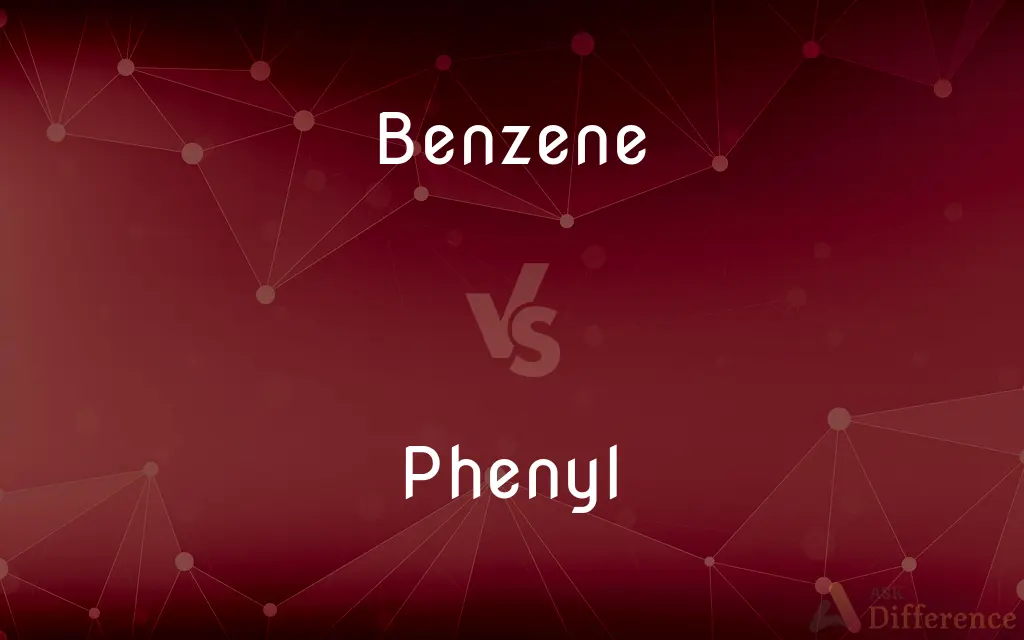Benzene vs. Phenyl — What's the Difference?
By Maham Liaqat & Fiza Rafique — Updated on April 16, 2024
Benzene is a stable aromatic hydrocarbon with a ring of six carbon atoms, while a phenyl group is a benzene molecule minus one hydrogen atom, acting as a functional group.

Difference Between Benzene and Phenyl
Table of Contents
ADVERTISEMENT
Key Differences
Benzene is a simple and stable aromatic compound consisting of six carbon atoms linked in a planar hexagonal ring with alternating double bonds, known for its resonance stability. Phenyl, on the other hand, is derived from benzene by removing one hydrogen atom, resulting in a C6H5 group that cannot exist independently but forms part of larger molecules.
While benzene itself is a complete molecule and can exist independently, a phenyl group acts solely as a substituent or part of other molecules, attaching through the vacant point where the hydrogen was removed. Whereas benzene can be isolated as a clear, colorless liquid in its pure form, phenyl groups are always seen bonded to other atoms or groups in chemical structures.
Benzene's applications are widespread in the chemical industry, used as a precursor to produce a variety of chemicals including plastics, resins, and synthetic fibers. On the other hand, phenyl groups are key in modifying the properties of organic molecules, influencing everything from the physical stability of plastics to the effectiveness of pharmaceuticals.
Benzene's toxicity and ability to cause cancer are well-documented, making its handling and use heavily regulated. Phenyl groups, however, do not exhibit toxicity independently since they are not standalone molecules, but their presence in other compounds can affect the overall toxicity of those substances.
In terms of reactivity, benzene is relatively inert due to its aromatic stability; however, it can undergo reactions like halogenation and sulfonation under specific conditions. Phenyl groups, meanwhile, can enhance the reactivity of compounds they form part of, particularly in organic reactions like electrophilic substitution, due to the electron cloud of the aromatic ring.
ADVERTISEMENT
Comparison Chart
Basic Structure
Complete, stable ring of C6H6
Fragment of benzene, C6H5
Existence
Can exist independently
Exists only as part of molecules
Applications
Used widely in manufacturing chemicals
Modifies properties of compounds
Toxicity
Toxic and carcinogenic
Influence toxicity when part of compounds
Reactivity
Inert, but reacts under specific conditions
Enhances reactivity of compounds
Compare with Definitions
Benzene
A clear, colorless liquid at room temperature.
Benzene evaporates quickly when exposed to air.
Phenyl
A benzene ring minus one hydrogen atom, used as a functional group.
The phenyl group affects the reactivity of the molecule it's attached to.
Benzene
Known for its ring structure characterized by resonance.
The stability of benzene comes from its resonating structures.
Phenyl
Acts as a substituent in organic chemistry.
Phenyl groups are common in pharmaceutical compounds.
Benzene
An aromatic hydrocarbon with a formula C6H6.
Benzene is used as a solvent in many chemical processes.
Phenyl
Cannot exist independently; always part of a larger molecule.
A phenyl group is bonded to the main chain in biphenyl.
Benzene
A constituent of crude oil and a basic petrochemical.
Benzene is extracted through the distillation of petroleum.
Phenyl
Involved in the synthesis of many drugs and plastics.
Phenyl groups are crucial in the structure of aspirin.
Benzene
Regulated due to its carcinogenic properties.
Factories limit benzene emissions to protect worker health.
Phenyl
Influences the properties of molecules, including solubility and boiling points.
The presence of a phenyl group increases boiling points.
Benzene
Benzene is an organic chemical compound with the molecular formula C6H6. The benzene molecule is composed of six carbon atoms joined in a planar ring with one hydrogen atom attached to each.
Phenyl
An aromatic hydrocarbon unit, C6H5, that can occur as a substituent in an organic compound or as an ion or radical, structurally related to benzene.
Benzene
A colorless, flammable, toxic, liquid aromatic hydrocarbon, C6H6, derived from petroleum and used in or to manufacture a wide variety of chemical products, including DDT, detergents, insecticides, and motor fuels. Also called benzol.
Phenyl
(organic chemistry) A univalent hydrocarbon radical (C6H5) formally derived from benzene by the removal of a hydrogen atom, and the basis of an immense number of aromatic derivatives.
Benzene
(organic compound) An aromatic hydrocarbon of formula C6H6 whose structure consists of a ring of alternate single and double bonds.
Phenyl
A hydrocarbon radical (C6H5) regarded as the essential residue of benzene, and the basis of an immense number of aromatic derivatives.
Benzene
Sometimes used in place of the phenyl group.
Benzene
A volatile, very inflammable liquid, C6H6, contained in the naphtha produced by the destructive distillation of coal, from which it is separated by fractional distillation. The name is sometimes applied also to the impure commercial product or benzole, and also, but rarely, to a similar mixed product of petroleum.
Benzene
A colorless liquid hydrocarbon; highly inflammable; carcinogenic; the simplest of the aromatic compounds
Common Curiosities
Are benzene and phenyl the same?
No, benzene is a complete molecule, while phenyl is a functional group derived from benzene by removing one hydrogen.
Is benzene dangerous?
Yes, benzene is toxic and has been classified as carcinogenic.
Can phenyl groups exist independently?
No, phenyl groups cannot exist independently; they must be attached to other atoms or groups.
What is benzene used for?
Benzene is primarily used in the manufacture of other chemicals, including plastics, resins, and synthetic fibers.
How does the phenyl group affect the properties of a molecule?
Phenyl groups can change the physical and chemical properties of molecules, such as increasing boiling points or altering solubility.
How are benzene and phenyl groups used in industry?
Benzene is used as a base material in the chemical industry, while phenyl groups are used to enhance the properties of organic molecules.
Can benzene be found in everyday products?
Yes, benzene is present in a variety of products including plastics, rubbers, and certain detergents.
Why can’t phenyl groups exist alone?
Phenyl groups lack sufficient hydrogen atoms to maintain stability as independent entities.
How does the presence of a phenyl group influence reactivity?
Phenyl groups can increase the reactivity of the molecules they are part of, especially in aromatic substitution reactions.
What distinguishes a phenyl group from a benzyl group?
A phenyl group is simply a benzene ring minus one hydrogen, whereas a benzyl group includes an additional -CH2 group.
What kind of reactions can benzene undergo?
Benzene can participate in electrophilic substitution reactions such as halogenation and nitration.
What is the role of phenyl groups in pharmaceuticals?
Phenyl groups are involved in the synthesis and function of many drugs, affecting their efficacy and metabolic stability.
Does the presence of phenyl groups in a compound make it toxic?
Not necessarily; the overall toxicity depends on the structure and other components of the compound.
How is benzene regulated?
Benzene is heavily regulated in many countries due to its health risks, with strict limits on its use and emissions.
What safety measures are necessary when handling benzene?
Proper ventilation, protective clothing, and adherence to safety regulations are essential due to benzene’s toxicity.
Share Your Discovery

Previous Comparison
Precede vs. Succeed
Next Comparison
Acrylate vs. MethacrylateAuthor Spotlight
Written by
Maham LiaqatCo-written by
Fiza RafiqueFiza Rafique is a skilled content writer at AskDifference.com, where she meticulously refines and enhances written pieces. Drawing from her vast editorial expertise, Fiza ensures clarity, accuracy, and precision in every article. Passionate about language, she continually seeks to elevate the quality of content for readers worldwide.














































